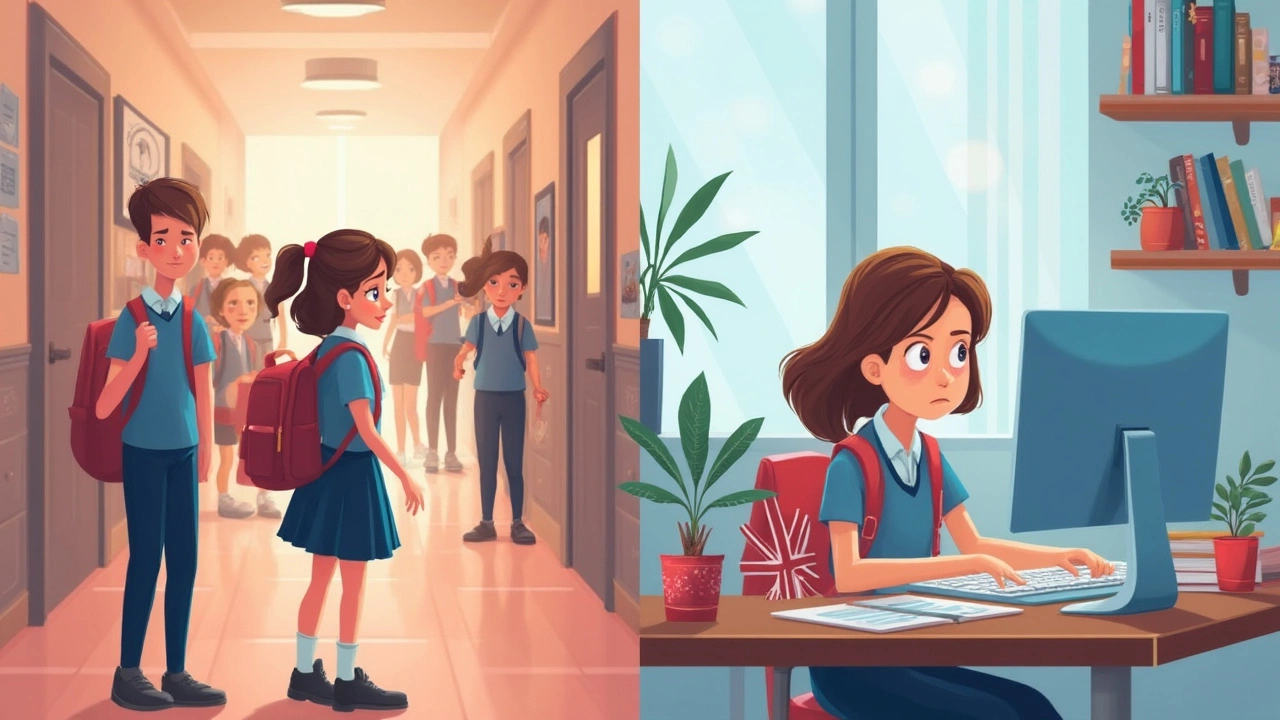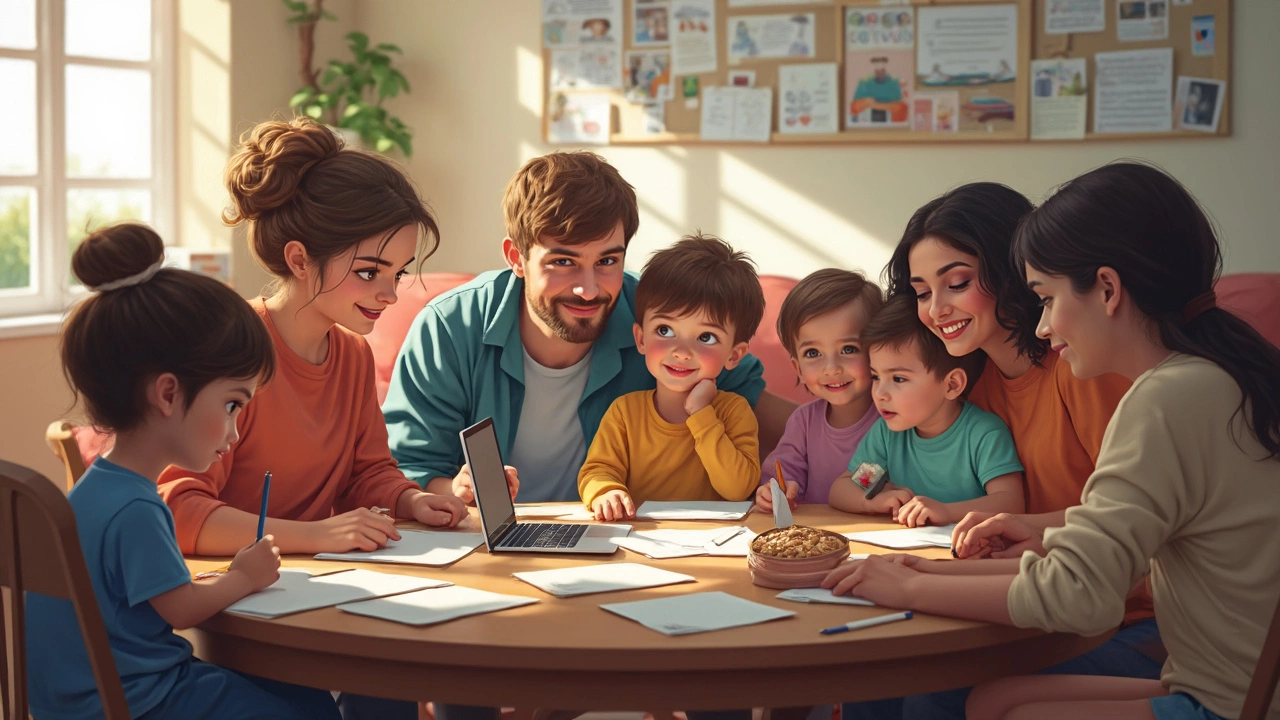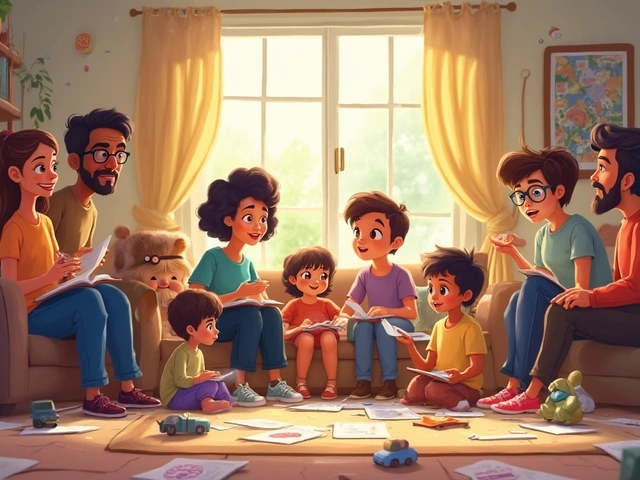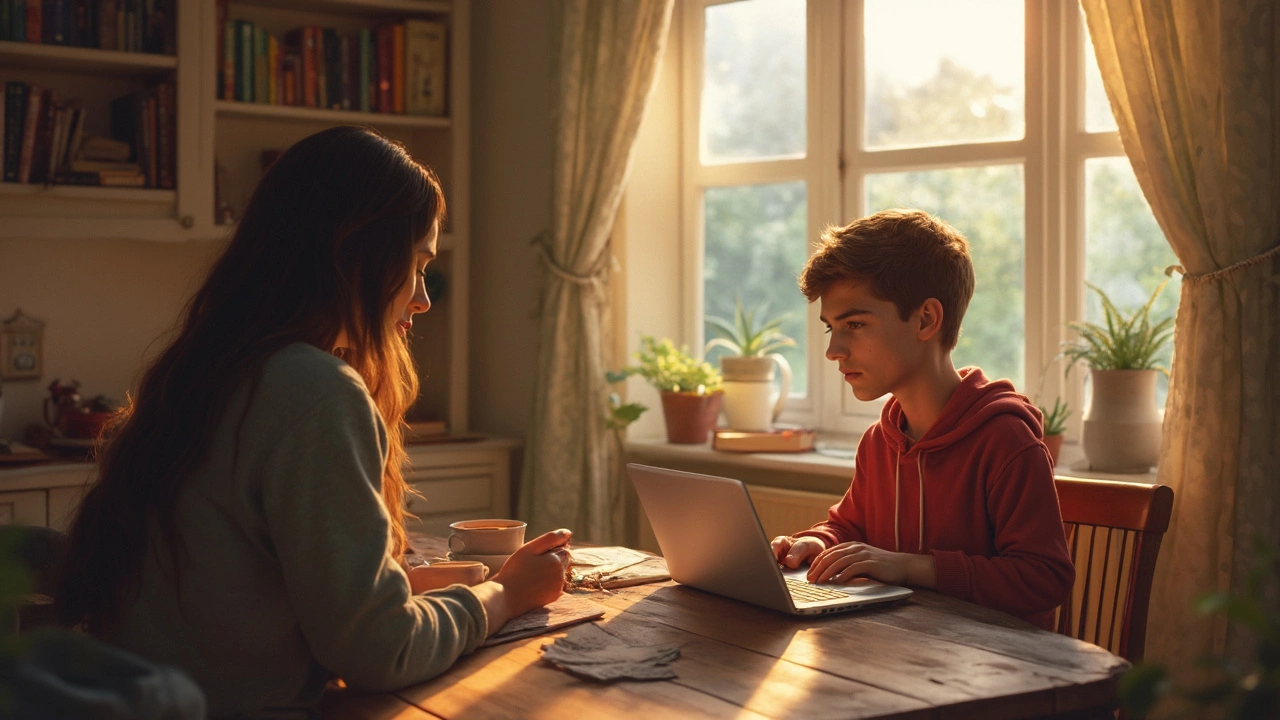If your kid deals with anxiety, the thought of a packed hallway or a loud classroom can make them want to hide under the covers for days. For some families, online school seems like an answer—no early rush, no lunchroom drama, and way fewer awkward social moments.
But does swapping school desks for Zoom calls actually make life easier for anxious kids? It’s not as clear-cut as you might think. Sure, learning at home can take a load off by letting kids control their environment—no worrying about bumping into bullies or speaking up in front of a crowd. That alone can be a huge relief.
Still, the story doesn’t stop there. Just because a kid is at home, it doesn’t mean their worries just vanish. New challenges pop up: technical glitches, missing face-to-face connections, and the sneaky way isolation can creep in. If you’re juggling the idea of online school, knowing what really helps—and what trips kids up—is crucial before making the big switch.
- What Triggers School Anxiety?
- How Online School Changes the Game
- Hidden Problems in Distance Learning
- Simple Tips to Ease Anxiety Online
- Is Online School the Right Call for Your Kid?
What Triggers School Anxiety?
There’s no single reason kids get anxious about school—usually, it’s a mashup of stuff that builds up over time. Some kids worry about keeping up in class, while others dread social situations more than pop quizzes. Knowing what sets off anxiety can actually help you spot it earlier.
Here’s what tends to push kids over the edge:
- Academic pressure: Kids often freak out about grades, deadlines, or getting picked to answer questions. According to the online school support network Understood.org, almost 60% of students with anxiety get stuck on worries about failing or disappointing others.
- Social situations: The school environment is packed with unspoken rules. Making friends, dealing with drama, or just being called on in class can spark big worries. Social anxiety often shows up around ages 11 to 13—so middle school is prime time for jitters.
- Bullying: This is huge. Over 20% of students say they’ve been bullied, based on a CDC survey. That fear can turn every school day into a struggle.
- Big changes: Moving to a new school, switching teachers, or family stuff like divorce can ramp up stress overnight.
- Perfectionism: That need to do everything perfectly can be paralyzing. Kids might freeze up on assignments or refuse to try activities if they’re afraid of making mistakes.
Even physical stuff—like lack of sleep or hunger—can make school anxiety worse. The trick is, a lot of kids don’t talk about what’s bugging them. Instead, you see stomachaches, headaches, or fake sick calls right before the school bus arrives. These clues often come before you ever hear them say, “I’m worried.”
| Top Triggers | % of Kids Affected (US) |
|---|---|
| Academic Pressure | ~60% |
| Social Situations | ~35% |
| Bullying | 20-22% |
| Major Change | n/a |
| Perfectionism | up to 25% |
Getting a handle on what your kid’s dealing with is the first step to helping them figure out what kind of learning works best. Spotting the signs early makes it easier to find solutions that actually help—whether that’s a new school setting or just a different daily routine.
How Online School Changes the Game
Online school isn’t just a new backdrop—it flips the whole school experience. For kids with anxiety, this switch can shake up their daily stress in ways you might not expect. The biggest win? Most say their worst triggers just aren’t around anymore. No crowds, no surprise tests in front of the class, no bumping into kids they’d rather avoid. That extra control over their space gives some kids room to breathe.
An actual survey from the American Psychological Association showed that 79% of students with anxiety reported fewer panic moments during remote learning. It’s not all in their heads either. When you’re at home, you can step away for five minutes to regroup—try doing that in a busy school hallway!
Here are a few big ways online school really changes things for anxious kids:
- Online school gives them control: Need a break? Hit mute or turn off the camera for a quick breather without anyone clocking it.
- No public speaking: Many assignments let kids write their answers or record a video, instead of putting them on the spot live.
- Flexible schedule: Some platforms let students move through lessons at their own speed, lowering the pressure to keep up.
- Less peer pressure: Without a crowd, kids avoid a lot of the social stress found in traditional schools.
"Remote learning is the first time some of my anxious students have found class participation doable," shared Dr. Stacey Martinez, a child psychologist, in a 2023 interview with NPR. "Online options give them a sense of safety they never had before."
Here’s a peek at what parents have noticed, pulled from a 2024 nationwide poll:
| Benefit | Percent of Parents Reporting |
|---|---|
| Less Social Anxiety | 73% |
| Fewer Physical Symptoms (like stomachaches) | 62% |
| Improved Attendance | 55% |
None of this means online school is perfect, but it can offer big relief for kids whose anxiety ramps up with traditional routines.

Hidden Problems in Distance Learning
When you hear about online school, it sounds like an anxiety cure—no crowds, no hustle, no unwanted attention. But there’s a flip side most folks don’t talk about. The truth is, learning from home has its own set of headaches, especially for kids with anxiety.
One big thing to watch out for is loneliness. Studies in the past few years found that kids doing full-time online school tend to feel cut off from friends. That isolation can make their anxiety worse, sometimes more than when they were at regular school. Just because you’re skipping bullies doesn’t mean you’re building friendships on Zoom. Some anxious kids go days without a real back-and-forth chat, and it adds up.
Then there’s the pressure to be self-motivated. Distance learning dumps a lot of responsibility on kids to keep track of their time and assignments. Without a teacher hovering over their shoulder, anxious kids can spiral into worry. Did they miss something? Did they turn in that homework right? They might obsess over tiny details, lose sleep, or even avoid finishing tasks so they won’t make mistakes. That snowballs into lower grades or giving up on work entirely.
Tech issues are another hassle. Weak Wi-Fi, glitchy mics, or logging into the wrong class—these sound small, but for a kid already on edge, they can set off panic. Suddenly, a frozen screen turns into full-blown stress, leaving the student more anxious than before.
Also, teachers can miss early signs of struggles. In-person, a teacher spots when a kid looks pale, shaky, or seems upset. On a video call, those warning signs often slip through the cracks. Some kids never reach out for help because they’re embarrassed, or they don’t know how online. So, the problems build up until they get out of hand.
- If your kid has anxiety, ask how often they talk to classmates or if they feel left out.
- Help them break work into small, doable chunks, instead of big, scary deadlines.
- If tech troubles are common, create a step-by-step cheat sheet so anxiety doesn’t spike when things go wrong.
- Set up regular check-ins with teachers, even if it’s just a quick email, so nothing gets missed.
The biggest thing to remember? Online school isn’t just a different location—it changes everything about how your kid experiences school. Not every anxious kid finds relief when the classroom moves to the family kitchen.
Simple Tips to Ease Anxiety Online
Helping kids with anxiety get the hang of online school doesn’t mean you have to become a tech wizard or a full-time therapist. Small changes can make a big difference. Studies from Johns Hopkins and the CDC found that up to 1 in 5 kids has a diagnosable anxiety disorder, and many said their stress got worse over video calls and assignments piling up—but with the right moves, things get easier.
- Create a Set Routine: The chaos of home can make it easy to avoid schoolwork or lose track of time. A simple daily schedule (wake up, breakfast, log in, break, lunch) gives anxious kids something predictable. Post it somewhere everyone can see.
- Break Down Tasks: Big assignments can feel like a mountain. Help your kid split stuff into small, clear steps—like reading two chapters, taking a break, then doing the quiz. Checking off tasks gives them a sense of progress and control.
- Make Space for Breaks: A study from the University of Michigan showed that regular movement breaks boost mood and focus. Try short walks, stretching, or even a dance break. This isn’t just about skipping; our brains actually need the reset.
- Stay in the Loop: If your child’s teacher is on board, set up a weekly check-in. Some schools now offer office hours or support groups just to help kids talk through worries. Use them. Speaking up early means problems don’t spiral.
- Limit Distractions: Phones, gaming consoles, and even family chatter wreck focus. Set up a spot for school that’s just for learning. Earbuds help, too—especially for live lessons.
| Tip | What Happens |
|---|---|
| Routine | Better focus, lower morning stress |
| Breaking tasks | Less overwhelm, more done |
| Movement breaks | Bigger boost to mood and memory |
| Teacher check-ins | Troubles get solved faster |
| Less screen clutter | Fewer meltdowns, more calm |
If you feel like nothing is working, don’t wait it out. There’s no shame in reaching out to a school counselor or a mental health pro. Online learning is new for a lot of families. Getting outside help can make the whole process less rocky for everyone.

Is Online School the Right Call for Your Kid?
So, you’re weighing whether online school is really what your anxious kid needs. No two kids are the same, and neither are their causes of anxiety—so this is never a cookie-cutter choice. But there are some clear things you can look at to help you figure it out.
First off, let’s talk about environment. If your child gets the shakes just thinking about crowded spaces, strict schedules, or bullies, remote learning might take away some pretty big stressors. Many parents have seen their kids perk up once the pressure of daily face-to-face stuff disappears. According to a 2023 Pew survey, about 32% of parents with anxious kids said their child’s mood improved after switching to online school, at least for the first few months.
But here’s the flip side—about 40% of those same parents noticed new challenges over time. Stuff like feeling lonely, getting lost in the technology maze, or struggling to stay on track without help. So it’s not all sunshine and pajamas. Realistically, online school is a better fit for kids who:
- Get much more anxious from social situations than work itself
- Can manage time and tech with some independence—or have support from home
- Don’t thrive with in-person, on-the-spot tasks or crowded environments
- Get overwhelmed by sensory overload (loud noises, school hustle, etc.)
You’ll want to consider a few practical questions:
- Can you or another adult be around to help with tech snags or motivation?
- Is your kid open to remote counseling or online friend groups as support?
- Are they missing out on crucial hands-on activities or therapies at traditional school?
Sometimes, a blended approach (part in-person, part remote) works best. Some schools even offer flexible plans targeting kids with anxiety, so don’t be afraid to talk to teachers, counselors, or your district’s special services.
Here’s a quick look at what parents of anxious kids have reported about remote learning:
| Experience | Percentage (%) |
|---|---|
| Mood improved after switching | 32 |
| Struggled with isolation | 40 |
| Found schoolwork easier | 27 |
| Preferred in-person support | 38 |
Just because the option’s there doesn’t mean it’s always the answer. Talk openly with your child, do some test runs with online lessons if you can, and keep tabs on how they actually feel—not just how you hope things will go. Sometimes online school can be the best relief for a kid with anxiety. Other times, it’s just swapping one set of worries for another. The right call keeps your kid’s actual day-to-day experience at the center—not just what looks good on paper.






